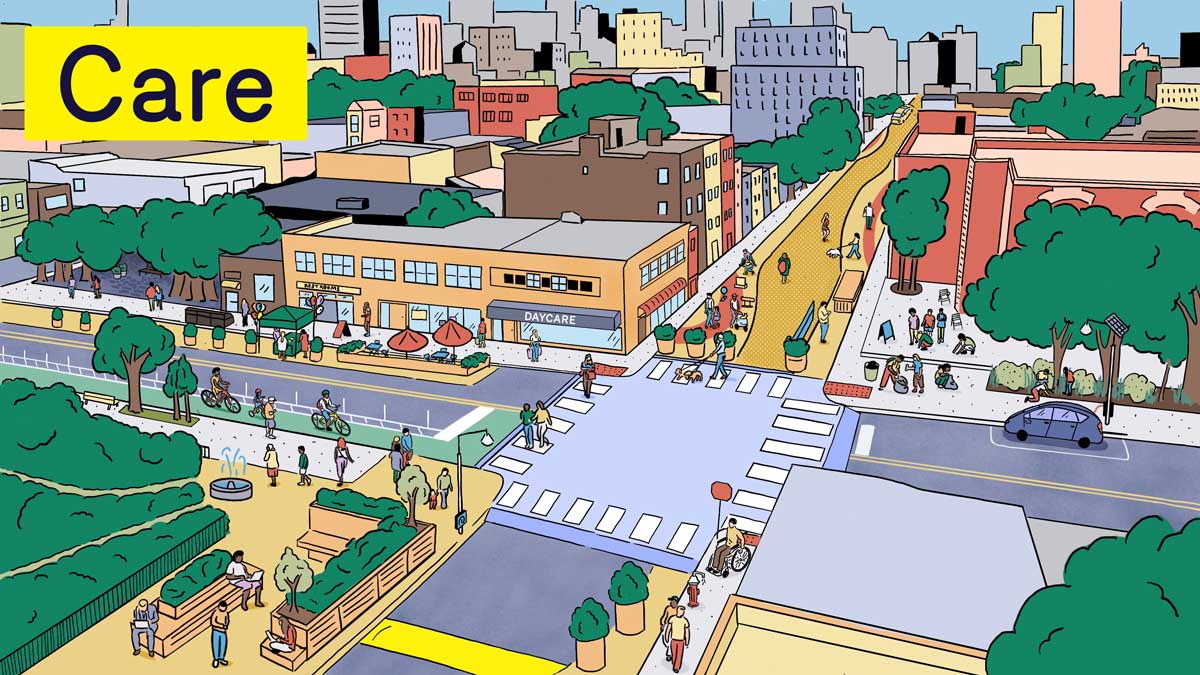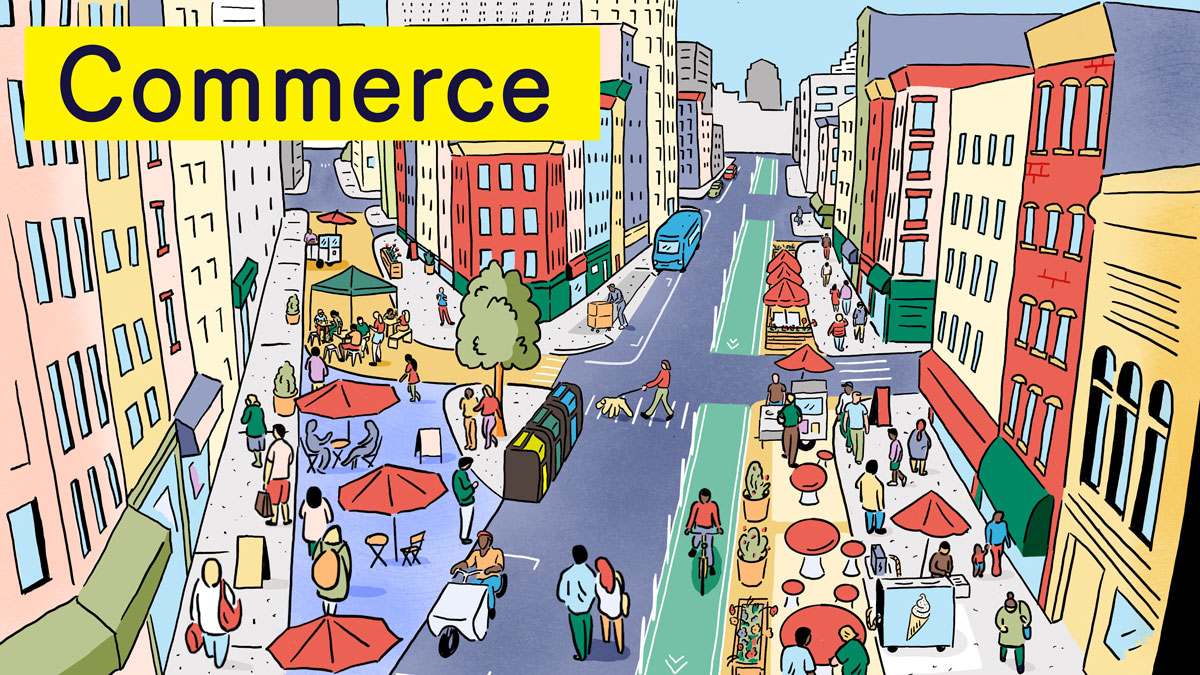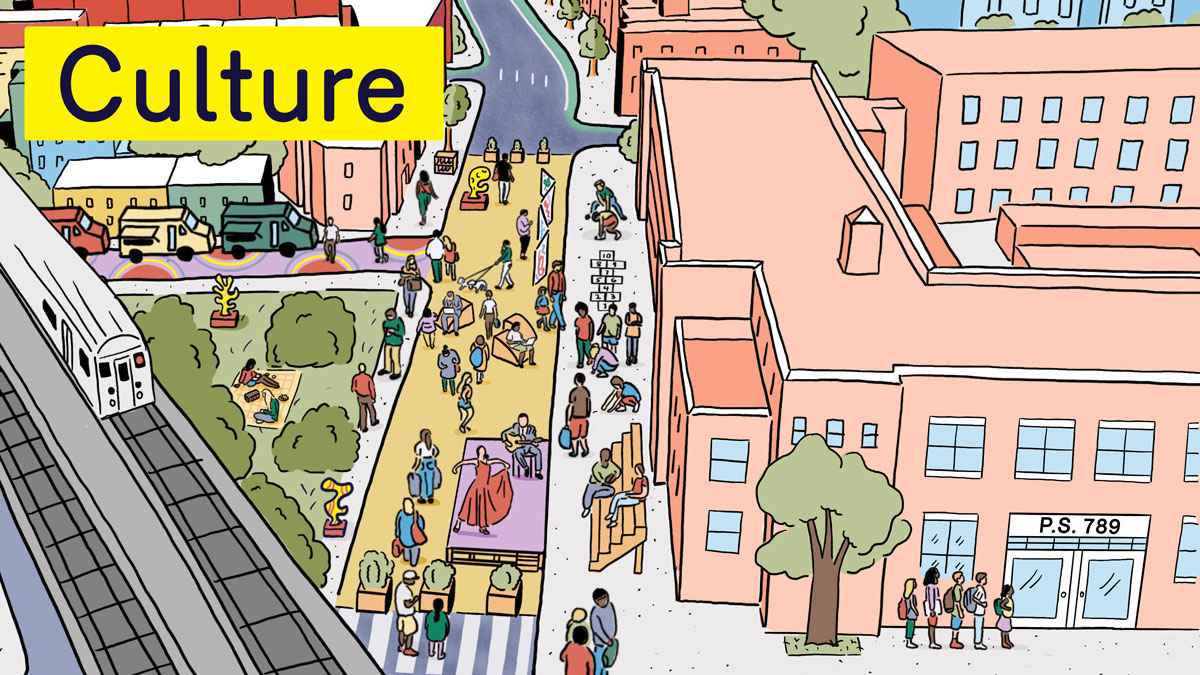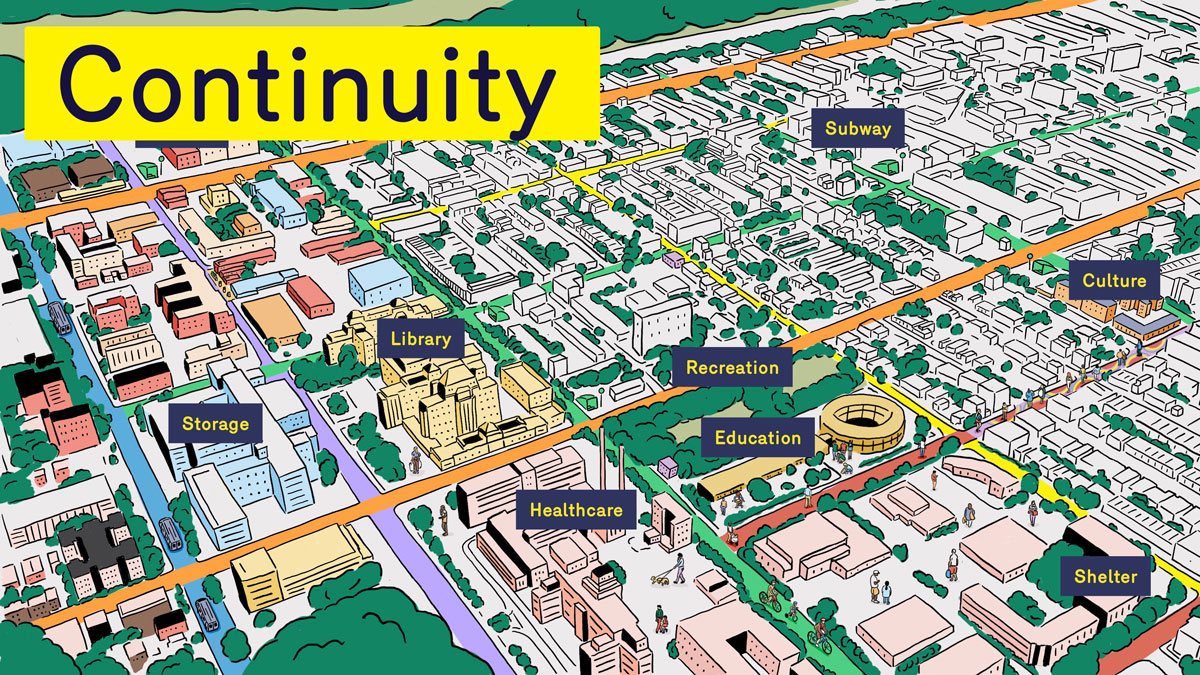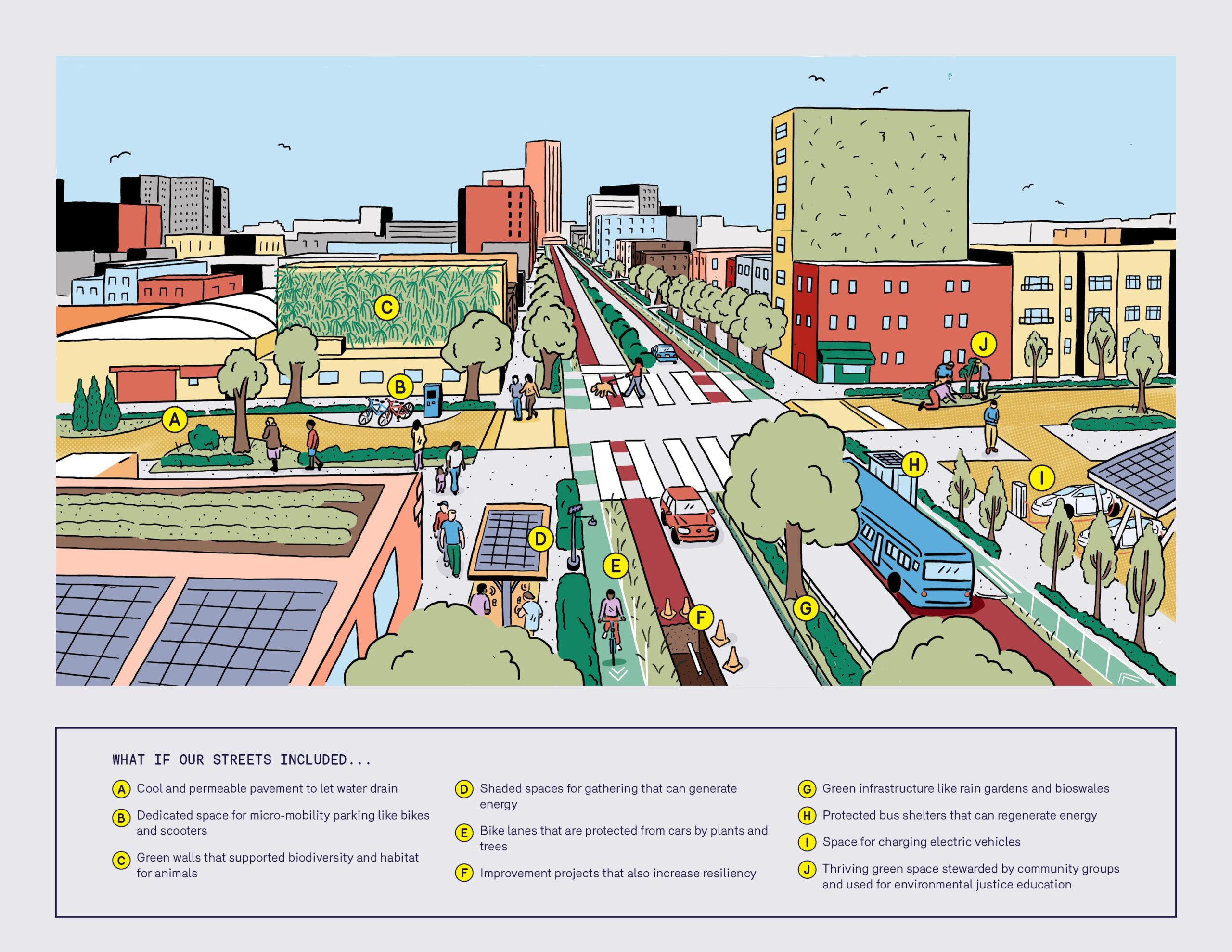
The Vision
The climate crisis is at our doorstep. We must ensure that all New Yorkers are safe not only from vehicular violence, but also from dangerous effects of the public health crisis that is climate change.
Last Summer, Hurricane Ida reminded us that New Yorkers are at risk of death, injury, and displacement by increasingly severe weather events that cause landmark flooding and extreme heat. NYC’s Heat Vulnerability Index [1] reveals that Black and brown neighborhoods that were hit hardest by the COVID-19 pandemic are also the most vulnerable during heat waves and disproportionately impacted by poor air quality.
With streets encompassing over 25% of New York City’s land area, [2] these dark, impervious surfaces contribute significantly to the rising temperatures and stormwater runoff that are putting so many of residents and businesses at risk. Neighborhoods that have faced decades of disinvestment are also often without green spaces that create cooler and cleaner air [3].
To fight decades of environmental racism, we must equip environmental justice communities with the tools to battle extreme weather.
We envision Climate Streets in three ways:
- Climate Streets reclaim 25% space for nature and habitat that support biodiversity, sequester greenhouse gas emissions, reduce urban heat, and mitigate inland flooding.
- Climate Streets reclaim 25% space for zero-emission transportation and a range of micro-mobility options to improve health and safety in our streets.
- Climate Streets reclaim 25% space for people to move about and enjoy streets safely and reduce our dependence on private, carbon-intensive vehicles.
Recommendations
1. Enact a Street Climate Action Plan to be implemented in all public Right of Way projects.
NYC’s Chief Climate Officer could spearhead a Street Climate Action Plan (Street CAP) that urges all street decisions to support the realization of Climate Streets. Integrated into the Streets Plan, and following guidance from DSNY, DEP, DOT, the Mayor’s Office of Climate and Environmental Justice (MOCEJ) and others, the plan could provide a framework for the coordination, multi-scale design, and ongoing maintenance of the city’s street network, and develop opportunities for partnerships with BIDs, Community Based Organizations (CBOs), and other organizational partners to enact the plan.
ACT NOW: Mobilize a Climate Action Task Force.
In 2023, the Interagency Public Realm Working Group should convene a Climate Action Task Force to strategize how to achieve Climate Streets. This group could be responsible for setting clear citywide goals and enacting the process for creating a Street CAP.
The task force could also partner with DOT and the NYC Department of Design and Construction (DDC)’s leadership to develop an evaluation framework to review every project within the public Right of Way to ensure it supports and prioritizes climate adaptation and decarbonization goals.
2. Use the Healthy Streets Program to expand the urban tree canopy by 25%.
Increasing the city’s street tree canopy, which was estimated to be 22% in 2017 [4], is vital to reducing the Urban Heat Island Effect, improving air quality, and increasing biodiversity. The City could leverage the Federal Infrastructure Bill (H.R. 3684) [5]’s Healthy Streets Program to increase tree cover by 25% in neighborhoods most immediately impacted.
ACT NOW: Launch the ‘NEXT Million Trees’ project.
The Mayor could build on the success of Million Trees NYC by committing to another million trees by 2030. By advancing the Greenstreets Agreement between NYC Department of Parks and Recreation (DPR) and DOT, the City could expand partnerships with existing organizations like the Natural Areas Conservancy, and empower environmental justice organizations by funding tree-planting in their initiatives. The City could also further invest in the existing urban parkway system through the DOT Greenway program.
3. Mobilize federal investment to support community stewardship and climate mitigation.
To increase funding, the City could make most of the Infrastructure Investment and Jobs Act through Community Development Block Grants by appropriating funding to capital improvements that directly address climate mitigation in historically underinvested residential communities.
City agencies could explore opportunities to increase funding to community-based organizations or BIDs to run programs for the stewardship of nature-based solutions in the Right of Way, including tree planting, youth education, plant cultivation, and environmental justice education.
ACT NOW: Expand Cool Streets this Summer.
The City could invest and expand on Cool Streets, part of the Cool it! NYC program to equip neighborhoods with misting stations, hydrant caps, and shading structures on more streets in the warmest months, to ensure that communities can safely enjoy the public realm and seek respite.
4. Pilot new nature-based solutions in the Right of Way.
MOCEJ could partner with community-based organizations in environmental justice neighborhoods to identify and implement new strategies that reduce climate risks like native planted areas, pollinator gardens, and blue infrastructure in the roadway. Use pilot initiatives to test and improve upon existing technology like permeable paving, shade structures, and bioswales in the Right of Way. Support community-driven projects like the Clean Air Green Corridor on 182nd Street in realizing their visions.
ACT NOW: Pilot new street cooling designs.
In 2023, the City could fund local community-based organizations to pilot their own Cool Streets programs, incentivizing local participation in community design competitions, block parties, and more. The City could engage with designers to test new flexible, low-cost methods for cooling on the streets, applying lessons from pilots like Refreshing Waters.
ACT NOW: Invest in the maintenance of nature-based solutions.
The City could advance their goals of creating more green jobs by allocating new funding for staff to DPR and NYC Department of Environmental Protection (DEP) and to workforce organizations like the Horticultural Society to support ongoing maintenance of nature-based solutions in the Right of Way.
5. Install energy generating technologies in the Right of Way.
DDC could make the most of the Right of Way as a place for generating alternate sources of energy by using innovative technologies such as street illumination powered by solar panels, battery charging stations, or solar canopies over public shading structures.
ACT NOW: Ignite new design ideas for energy generating shading structures.
In 2023, the City could partner with a design organization to facilitate the generation of new ideas for structures like bus shelters and canopy seating in the Right of Way that could serve multiple purposes for climate benefit, such as shading, energy generation, or misting.
6. Use congestion pricing to invest in solutions to decarbonize city streets.
Currently, less than 1% of vehicles registered in the five boroughs are electric. The City should continue to create substantial opportunities for New Yorkers to use reliable, safe public transportation, and expand ways to access transportation methods such as e-bikes, scooters, and car-shares. The City could surpass its goal of 10,000 new electric vehicle charging stations in the street by 2030.
ACT NOW: Fast track PlugNYC.
DOT could expand their target of new curbside electric vehicle charging stations to 3,000, beating the commitment of 1,000 set forth in Electrifying New York.
ACT NOW: Implement one ultra-low emission zone in each borough.
Cities like Barcelona and London have successfully implemented zones in their city centers that restrict access for the highest polluting vehicles. Prioritizing environmental justice neighborhoods first, New York could follow suit by identifying a zone in each borough to implement similar efforts that will improve air quality and reduce congestion. Explore adding into the current Congestion Pricing scheme.
7. Zoning for Climate Streets.
The City could work with DCP to undertake a review of zoning and building codes to better understand potential barriers and opportunities for realizing Climate Streets. Revisiting elements like Zone Green and the Yards Text Amendment could serve as a starting point to transform regulations as needed to support climate goals.
ACT NOW: Transform CEQR to center climate impact.
The City Environmental Quality Review (CEQR) could be a powerful tool to prioritize climate adaptation and decarbonization in the street. The City could restructure current CEQR staff and resources to prioritize climate adaptation and decarbonization goals.
8. Study co-benefits of nature-based solutions for economic growth and health.
Drawing from existing resources like the NYC Street Tree Map, and the Trust for Public Land’s Economic Benefits of Parks in NYC Report, the City could launch a study to assess the benefits of nature-based solutions to make the case for broader investment. The City could work with the Comptroller’s Office and the Independent Budget Office (IBO) to conduct cost-benefit analyses for small scale projects. DEP and MOCEJ could partner with SBS and the Department of Health and Mental Hygiene (DOHMH) to study how investments like tree plantings, green infrastructure, habitat restoration, and use of renewable energy can have cross-sector benefits including economic growth and lower public health costs.
